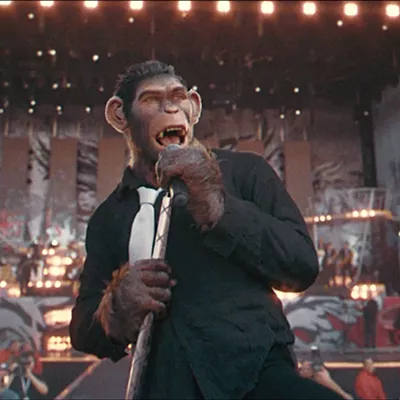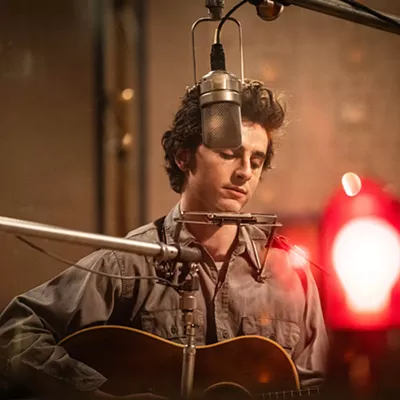The Brutalist is a film as stubborn and as challenging as its protagonist. Adrien Brody's László Tóth is a Hungarian-Jewish architect who survives the Holocaust and rebuilds his life in postwar America. And the movie mirrors his journey, one centered on trauma fueling inspiration and the creative struggle between artistic vision and the practicalities of patronage. The film and László's creations are a rebuke to a collapse of customs and traditions. And both are monumental.
This is a story of immigration that lets us know from the get-go that it will not gently handle, as so many movies do, one the greatest upheavals a person can experience: starting over in a new culture far from home. One of the first images director Brady Corbet gives us — the first of many with a similar starkness and lack of sentimentality — is a dizzying, upside-down look at the Statue of Liberty as Brody's Tóth arrives on a refugee ship in New York harbor. It's an unsettling upending of a cinematic cliché, one that comes on the heels of the film's opening moments: the screen black, loud noises and bangs amid shouts. I thought at first that we were hearing the scene of a bomb shelter, with the cries being ones of fear, but we're merely in the below decks with refugees excited to have reached their destination. It sets a disquieting tone for all that is to come in László's tale, when we're frequently as on edge as he is.
After a brief, lonely interlude in New York City, László — separated by war from his wife and teenage niece — arrives in Philadelphia to settle in with seemingly the only other family he has left: his cousin, Attila (Alessandro Nivola). Once there, he begins to work as part of his cousin's furniture business. Corbet — who wrote the screenplay with his regular writing (and life) partner, Mona Fastvold — is unhurried in depicting László's yearslong climb back to creating the massive architectural works for which he was celebrated in prewar Europe. Eventually wealthy industrialist Harrison Lee Van Buren (Guy Pearce) commissions László to build a community center in honor of Van Buren's deceased mother.
This job is the canvas upon which the great trials of László's new life will take place, as he eventually must battle Van Buren to maintain his artistic vision, which incurs some violent pushback. At the same time, László also falls prey to the hedonistic life in America and the messy joy that sheer survival prompts while also enduring bigotry as an immigrant. That ramps up once his wife, Erzsébet (Felicity Jones), and niece Zsófia (Raffey Cassidy) are finally able to join him in Pennsylvania. Brody's performance is extraordinary, full of flinty anger, palpable melancholy and repressed sorrow.
Harsh realities of American culture simmer in László's story and also in the meta reality of The Brutalist. We so rarely see films like this one anymore. Uncomfortable, complex adult dramas, where they exist at all nowadays, have retreated to streaming services, often as series to be snacked upon or binged at home. But Corbet — with his third feature, following 2015's The Childhood of a Leader and 2018's Vox Lux — has pulled out all the stops to remind us what cinema used to be and (one senses the desperate urgency of subliminal appeal) could be again.
Lol Crawley's austere cinematography is gorgeously showcased in a high-resolution widescreen format called VistaVision, a precursor to IMAX developed in the 1950s to better compete then with television and doing the same job again now. It lends an extra sensation of the epic to the three-and-a-half-hour runtime. Every minute feels justified and zips by — the retro presentation even comes complete with a musical overture opening and a 15-minute intermission at a satisfying point.
All this is possible because Corbet independently financed the film — there were no studio bosses with their fingers in the pie, meddling to make it more commercial — and produced it on a budget of under $10 million, which is shockingly little for a historical drama (for comparison last year's Oscar-nominated historical dramas Oppenheimer and Killers of the Flower Moon respectively cost about $100 million and $200 million). Nothing here feels as minimalist as László's concrete brutalism — except maybe the careful parsimony with which Corbet reveals László's secrets — but spending what amounts to only Hollywood pocket change was certainly key to getting this daringly original film made in the form we got it in.
The Brutalist, then, demands our full attention as a moviegoing experience. It demands to be seen on the biggest screen possible: IMAX, 70mm, etc. It feels like a reprimand for how we as a culture have let serious movies be diminished, a trend that COVID stay-at-home orders only exacerbated, with their concomitant rush to make movies available to watch at home. The Brutalist reminds us what we have lost in our subdued traumatized present that, in many ways, echoes László's world of the past.



















